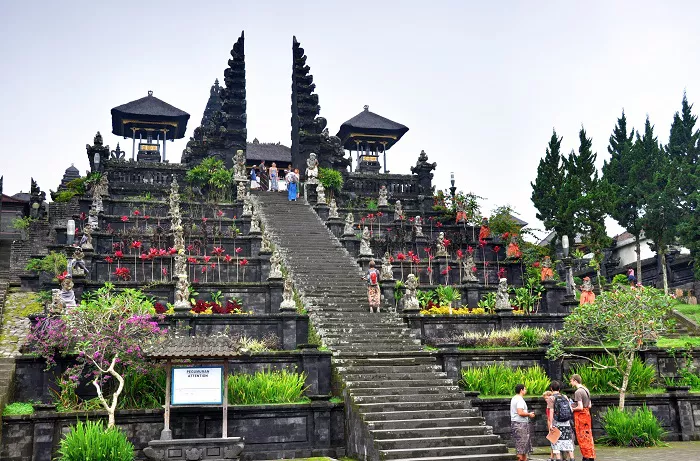Known as the “Island of the Gods,” Bali, Indonesia, is a sanctuary where spirituality and natural beauty intertwine. The island’s landscape is dotted with temples, or pura, each serving as a testament to Bali’s rich Hindu heritage and its people’s devotion. These temples are not merely architectural feats; they are living centers of worship, culture, and community. In this article, we delve into the most significant temples in Bali, offering insights into their history, architecture, and cultural importance.
1. Pura Besakih: Bali’s Mother Temple
Perched on the majestic slopes of Mount Agung, Pura Besakih stands as Bali’s holiest and largest temple complex. Comprising 23 temples, it serves as the spiritual heart of the island. The main temple, Pura Penataran Agung, is dedicated to the Hindu trinity of Brahma, Vishnu, and Shiva. The temple’s terraced layout symbolizes the spiritual ascent towards the divine. Despite surviving the catastrophic 1963 eruption of Mount Agung, Pura Besakih remains a beacon of resilience and faith. Visitors are advised to be aware of unofficial fees sometimes requested by local guides, which have been a point of contention for tourists.
2. Pura Ulun Danu Batur: Temple of the Lake Goddess
Located near the serene Lake Batur in Bangli, Pura Ulun Danu Batur is dedicated to Dewi Danu, the goddess of water. This temple is a vital part of Bali’s water temple system, which UNESCO recognized for its cultural significance. The temple’s architecture harmonizes with the surrounding natural beauty, offering visitors a tranquil retreat. Its role in maintaining the island’s water supply underscores the deep connection between Balinese spirituality and nature.
3. Pura Taman Ayun: A Royal Garden Temple
Situated in Mengwi, Pura Taman Ayun is renowned for its expansive gardens and intricate water features. Built in the 17th century by the Mengwi dynasty, the temple’s design reflects the Balinese concept of Tri Hita Karana, emphasizing the balance between humans, nature, and the divine. The temple’s multi-tiered shrines, surrounded by moats and lush greenery, create a serene atmosphere, making it a popular destination for both worshippers and tourists.
4. Pura Tirta Empul: The Holy Spring Temple
In the village of Tampaksiring, Pura Tirta Empul is famed for its holy spring water, believed to possess purifying properties. Established in 962 A.D., the temple’s bathing pools are a site for Melukat, a purification ritual practiced by Balinese Hindus. The temple’s historical significance and its role in spiritual cleansing attract visitors seeking both cultural insight and personal reflection.
5. Uluwatu Temple: Cliffside Serenity
Perched on a dramatic clifftop in Pecatu, Pura Luhur Uluwatu is dedicated to Sang Hyang Widhi Wasa in his manifestation as Rudra. This sea temple offers breathtaking views of the Indian Ocean and is renowned for its Kecak dance performances during sunset. The temple’s location and its spiritual ambiance make it a must-visit for those seeking a blend of natural beauty and cultural experience.
6. Gunung Kawi: Ancient Royal Tombs
Located in Tampaksiring, Gunung Kawi is an 11th-century temple complex featuring ten rock-cut shrines carved into the cliffs. These shrines are believed to honor King Anak Wungsu and his family. The site’s historical and archaeological significance provides a glimpse into Bali’s royal past, making it a fascinating destination for history enthusiasts.
7. Pura Luhur Batukaru: Tranquil Mountain Retreat
Situated in the Tabanan region, Pura Luhur Batukaru is nestled amidst the lush rainforest of Mount Batukaru. This temple is one of Bali’s nine directional temples and is dedicated to the god Mahadewa. The serene environment and the temple’s dedication to nature’s elements offer visitors a peaceful sanctuary away from the island’s more tourist-heavy areas.
8. Pura Sakenan: Island Temple of Serangan
Located on Serangan Island, Pura Sakenan is a significant temple for the Balinese people, especially during the Kuningan festival. The temple’s coastal setting and its role in community rituals highlight its importance in Balinese spiritual life. Visitors can experience the temple’s vibrant ceremonies and enjoy the surrounding natural beauty.
9. Pura Goa Lawah: Bat Cave Temple
Situated in Klungkung, Pura Goa Lawah is famous for its bat-filled cave, which is considered sacred. The temple is dedicated to the god Ganesha and serves as a place of worship and spiritual reflection. The unique setting and the temple’s association with the underworld make it a compelling site for those interested in Balinese mythology and religious practices.
10. Pura Masceti: A Hidden Gem
Located in Gianyar, Pura Masceti is a lesser-known temple that offers a more intimate spiritual experience. Surrounded by rice fields and traditional villages, the temple provides insight into the daily religious practices of the Balinese people. Its tranquil setting makes it an ideal spot for meditation and reflection.
Conclusion: Embracing Bali’s Spiritual Essence
Bali’s temples are more than just architectural marvels; they are living embodiments of the island’s spiritual and cultural heritage. Each temple offers a unique glimpse into the Balinese way of life, where religion, nature, and community are intricately woven together. Whether you’re seeking spiritual enlightenment, cultural understanding, or simply a moment of tranquility, Bali’s temples provide a profound experience that resonates long after your visit.

